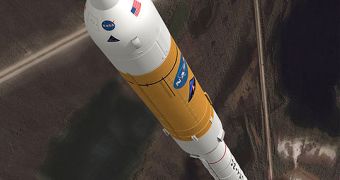The ARES delivery systems I, IV and V are all part of NASA's Project Constellation, which was designed as a replacement for the Shuttle Program. With the current fleet scheduled to be withdrawn from active duty by the end of 2010, the pressure is high on the space agency to come up with the new spacecraft as soon as possible. However, that seems unlikely to happen by the 2015 deadline, considering the numerous delays and cost overruns the project has been plagued with. In the latest such development, the first test flight of the ARES I rocket has been pushed back another two months.
Work continues in parallel on the ARES I-X delivery system and on Launch Pad 39B, at the Kennedy Space Center, in Florida. The facility has been transferred to Project Constellation after the successful return of the STS-125 Atlantis mission, from fixing the Hubble Space Telescope. Workers and engineers have then begun the work of adapting the launch pad to the new generation of rockets, a process that is expected to be completed soon. However, the rocket prototype itself is not yet completed, so renovations at the pad are somehow useless, considering they are, at this point, done for nothing.
In another development, the American space agency is currently under review by the Obama Administration, which is interested in learning if the ARES I rocket is, indeed, the best way of taking astronauts to low-Earth orbit and the International Space Station starting 2015. The review is highly important, because the recommendations that the inspectors make could lead to less or more funding, depending on the conclusions of the investigations. The original test, scheduled for April, was canceled on account of concerns related to the levels of vibrations that the rocket experienced during ascent.
The two-stage ARES I will be the crew-delivery component of Constellation, and will complement the workhorse ARES V. With a height of 94 meters (309 feet), and a diameter of 5.5 meters, it will be able to carry a payload of 25,000 kilograms (55,000 pounds) to orbit. The first stage of the new delivery system is manufactured by Alliant Techsystems, while the second one is currently under construction at Boeing. The maiden flight is scheduled for January 2014, Space reports.

 14 DAY TRIAL //
14 DAY TRIAL //